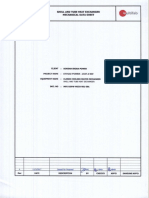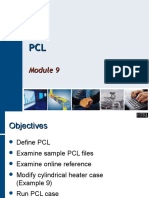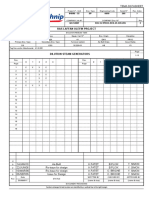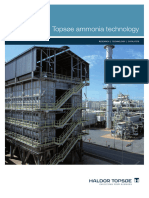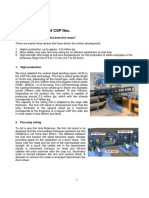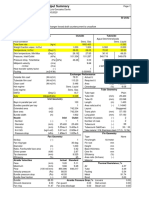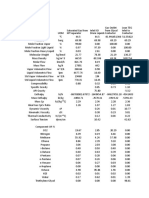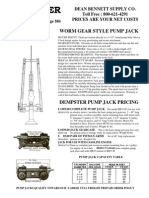Systimization and Circuitization Creation Case Study
Uploaded by
ahmed sobhySystimization and Circuitization Creation Case Study
Uploaded by
ahmed sobhyPAGE 2 OF 46
Case 1 - Normal Operation
Stream Number 0015 0016 0017 0018 0019 0020 0021 0023 0024 0025
WASH WATER OVHD VAPOR OVHD VAPOR LIQUID EXCESS REFLUX OFFGASES REBOILER REBOILER LEAN AMINE
TO FROM FROM FROM WATER TO TO TO (2-EA-002) (2-EA-002) FROM
2-DA-002 2-DA-002 2-EC-002 2-FA-001 OSBL 2-DA-002 INCINERATOR INLET OUTLET 2-EA-004
Case 1A 1A 1A 1A 1A 1A 1A 1A 1A 1A
Phase LIQUID VAPOR MIXED LIQUID LIQUID LIQUID VAPOR LIQUID MIXED LIQUID
mole %
METHANE 0.00 0.00 0.00 0.00 0.00 0.00 0.00 0.00 0.00 0.00
ETHANE 0.00 0.06 0.06 0.00 0.00 0.00 0.16 0.00 0.00 0.00
PROPANE 0.00 0.01 0.01 0.00 0.00 0.00 0.02 0.00 0.00 0.00
BUTANE 0.00 0.00 0.00 0.00 0.00 0.00 0.00 0.00 0.00 0.00
CARBON DIOXIDE 0.00 35.19 35.19 0.05 0.05 0.04 90.71 1.67 3.39 1.35
HYDROGEN SULFIDE 0.00 0.02 0.02 0.00 0.00 0.00 0.05 0.00 0.00 0.00
STEAM/WATER 99.99 64.69 64.69 99.91 99.91 99.92 9.05 88.11 96.56 86.52
DIGLYCOL AMINE 0.01 0.02 0.02 0.04 0.04 0.03 0.00 10.21 0.06 12.13
Mass Flow kg/hr 2,004 40,247 40,247 16,370 424 17,950 23,876 253,575 253,575 377,623
Molar Flow kg-mol/hr 111.15 1,479.72 1,479.72 906.18 23.48 993.85 573.53 9,270.43 9,270.43 13,049.04
Molecular Weight 18.03 27.19 27.19 18.07 18.07 18.06 41.62 27.35 18.94 28.94
Temperature °C 50.1 107.7 57.0 57.0 57.0 57.0 57.0 123.2 124.7 52.0
Pressure kg/cm2g 3.950 0.820 0.570 0.570 1.000 0.830 0.570 0.950 0.920 6.400
Vapor
Flow, mass kg/hr 0 40,247 23,876 0 0 0 23,876 0 50,712 0
Am3/hr 0 25,801 10,078 0 0 0 10,078 0 41,212 0
Molecular Weight 0.00 27.19 41.62 0.00 0.00 0.00 41.62 0.00 18.95 0.00
Density kg/m3 0.00 1.56 2.37 0.00 0.00 0.00 2.37 0.00 1.23 0.00
Viscosity cP 0.000 0.016 0.016 0.000 0.000 0.000 0.016 0.000 0.014 0.000
Cp/Cv 0.000 1.310 1.280 0.000 0.000 0.000 1.280 0.000 1.280 0.000
Compressibility 0.000 0.991 0.993 0.000 0.000 0.000 0.993 0.000 0.985 0.000
Liquid
Flow, mass kg/hr 2,004 0 16,370 16,370 424 17,950 0 253,575 202,863 377,623
m3/hr 2.03 0.00 16.58 16.58 0.43 18.67 0.00 260.07 209.29 363.79
Molecular Weight 18.03 0.00 18.07 18.07 18.07 18.06 0.00 27.35 29.01 28.94
Density kg/m3 986.0 0.0 987.2 987.2 987.2 961.7 0.0 975.0 969.3 1,038.0
Viscosity cP 1.01 0.00 0.52 0.52 0.52 0.52 0.00 0.39 0.40 1.67
Surface Tension dyne/cm 69.280 0.000 67.790 67.790 66.470 66.930 0.000 45.200 45.200 48.100
150898847-2.XLS ABB LUMMUS GLOBAL REV. 1
3.1.1 Interlock Description
Refer Appendix 9.5 for detailed interlock description of Ethylene Plant &
utilities.
3.2 Mercury Removal and Amine Treatment
3.2.1 Description
The feedstock contains a small amount of mercury, which can be removed in
the Mercury Removal Beds (2-FD-201A/B). The Mercury Removal Beds
(2-FD-201A/B) are located upstream of the amine absorber (2-DA-001). The
function of the Mercury Removal Beds is to absorb mercury from the C2/C3 feed
gas. Any mercury present in the C2/C3 feed gas, if allowed to pass into the
chilling train, would deposit in the brazed aluminum exchangers used in the
cold box, forming an aluminum-mercury amalgam. This mercury attack could
cause breach of pressure containment in the core exchangers, requiring
replacement of the cold box. There are two mercury removal carbon beds. One
is operating while the other is on standby. When the activated carbon bed life
expires, it must be disposed off and a new load of adsorbent must be utilized.
This can be done by switching operation to the equipment that is on standby.
The spent activated carbon can be discharged into drums or other suitable type
of container.
The feedstock contains a significant amount of carbon dioxide (CO2) as well as
some hydrogen sulfide (H2S) which is removed in the amine system using a
DGA solution.
The feedstock is contacted with a 45 wt% diglycolamine (DGA) solution in
countercurrent flow in the Acid Gas Absorber (2-DA-001). The treated
feedstock is then washed with water (condensate from the HP Steam
Blowdown Condensate Cooler 2-EA-131) in the top section of the absorber, to
Page 243 of 1363
SECTION 3 - OPERATING VARIABLES & CONTROL
prevent DGA carryover, and then sent to the Cracking Heaters. The feedstock
leaves the absorber with the CO2 reduced down to a level of 100 ppmw and
saturated with water at the absorber temperature and pressure. The rich DGA
solution leaving the bottom of the absorber is heat exchanged with lean DGA,
stripped of CO2 and H2S in the Amine Stripper (2-DA-002), cooled and recycled
back to the absorber. The Amine Stripper operates at the lowest possible
pressure based on the operating pressure of the incinerator. The tower utilizes
air as the condensing medium and low pressure steam as the heating medium.
The desorbed light hydrocarbons and steam are routed to the incinerator
where they are burned. Provisions are included to remove any contaminants in
the DGA solution via the Amine Reclaimer (2-EA-003). This exchanger is used
to perform batch evaporation of the lean DGA, leaving behind the
contaminants to be disposed.
Make-up DGA is available to replace any DGA losses in the system. In order to
insure the stable operation of the system over the required plant run length,
antifoam injection will be used and a 20% slipstream of the lean amine solution
will be continuously filtered.
3.2.2 Operating Variable & Controls
The C2/C3 fresh feed coming from OSBL is send to mercury removal bed
(2-FD-201A/B) in order to remove traces of mercury. The inlet and outlet
mercury in the feed will be analysed by 2-AI-2013A/B. C2/C3 feed free from
mercury at ambient temperature, enters the bottom of the Acid Gas Absorber
(2-DA-001) on pressure control (2-PC-1077) to maintain the feedstock header
pressure. It passes first through the Feed K.O. Drum (2-FA-002) where any
condensate present will be separated and sent to the Wet Flare Drum on level
control (2-LC-0003). It then flows up through the column which is two beds
packed column. CO2 and H2S in the C2/C3 feedstock are removed by
countercurrent contact with 45 wt. % DGA solution recycled from the Amine
Page 244 of 1363
Stripper (2-DA-002) on flow control (2-FC-0006). The lean amine solution,
which is somewhat warmer than the feed gas to preclude the possibility of
condensing hydrocarbons in the solution, enters the Acid Gas Absorber below
the wash water draw-off tray. As it flows through the column, CO2 and H2S are
absorbed into the amine solution.
The heat of absorption raises the temperature of the solution as it flows down
the tower. The treated feedstock is passed through a demister pad and enters
the wash section at the top of the tower. The water wash section has three
bubble cap trays. Phosphate free boiler feed water (BFW) enters the top tray
on flow control (2-FC-0001) and flows countercurrent to the upward feedstock
flow to remove trace amounts of amine from it. The liquid from the water wash
section sump is sent on level control (2-LC-0001) to the Amine Stripper,
entering at the reflux line. In order to recover trace amounts of DGA in the
water, the C2/C3 vapor saturated with water is passed through a second
demister pad before going to the Ethane Feed Preheater (2-EA-130). A CO2
analyzer (2-AI-0003) is provided on this stream and another CO2 analyzer
(2-AI-0001) is provided on the C2/C3 feed line to the Acid Gas Absorber to
monitor the absorber performance.
Rich amine solution, containing up to 0.40 moles of CO2 per mole of DGA is
drawn from the sump of the Acid Gas Absorber on level control (2-LC-0005).
The pressure of the solution is reduced across the absorber level control valve
immediately before entering the Amine Stripper above the inlet distributor.
The rich amine solution increases in temperature as it passes through the
Lean/Rich amine Interchanger (2-EA-001A/B), entering the stripper at
101.7°C. As the solution flows down through the column, it contacts up flowing
steam stripping. This section of the stripper consists of two packed beds. Below
packed beds, lean amine solution is collected and drawn off to the Amine
Stripper Reboiler (2-EA-002A/B/C) which operates under thermosyphon
action. The Reboiler heating medium is desuperheated LP steam, which enters
Page 245 of 1363
on flow control (2-FC-0012) reset by the stripper overhead temperature
(2-TC-0015). Desuperheated steam is used to minimize amine degradation.
Hot solution at 124.7°C is returned to the base of the Stripper while the
stripping steam vapor produced in the reboiler flows back up the column.
Condensation of this steam supplies heat of desorption of CO2 from the rich
amine solution, while supplying sensible heat to the amine in the stripper
bottoms solution. The remainder of the steam is stripping vapor which dilutes
the vapor phase and lowers the partial pressure of CO2 to assist the stripping of
CO2 from the solution. The overhead temperature and pressure are controlled
to keep the CO2 partial pressure at its optimum value.
The lean amine solution from the bottom of the Amine Stripper flows through
the Lean/Rich Amine Interchanger (2-EA-001,A,B) is pumped back to the Acid
Gas Absorber on flow control (2-FC-0006) and cooled down to 57°C in the Lean
Amine Cooler (2-EC-001A/B) where the cooling medium is air, and then is
cooled further to 52°C in the Lean Amine Trim Cooler (2-EA-004) where the
cooling medium is cooling water.
The stripper overhead product, CO2 and water vapor, is cooled and partially
condensed in the Amine Stripper Condenser (2-EC-002A/B), then enters the
Amine Stripper Reflux Drum (2-FA-001). The liquid from this reflux drum is
returned as reflux on flow control (2-FC-0011) with reset from the reflux drum
level controller (2-LC-0010) to the Amine Stripper top liquid distributor, which
is located above the top tray. The excess condensate is sent to waste water
treatment on flow control (2-FC-0014). The stripper overhead pressure is
controlled by venting the CO2 to the incinerator through the "B" pressure
controller (2-PC-0023) on high pressure, or drawing in nitrogen through the
"A" pressure controller (2-PC-0023) on low pressure. The Amine Reclaimer
(2-EA-003) is a kettle type heat exchanger which removes solution heat stable
salts, along with decomposition and degradation products from the circulating
amine. The reclaimer processes, in a semi-continuous operation, a slip stream
Page 246 of 1363
(approx. 2%) of lean amine which enters from the stripper bottom on level
control (2-LC-0008). Caustic solution is manually added to the reclaimer feed
to decompose any heat stable salts. The reclaimer can also process a slip
stream from the Amine Sump or the Amine Storage tank. The reclaimer utilizes
saturated HP steam, which enters on flow control (2-FC-0010) as the heating
medium to vaporize the liquid in this kettle. Due to accumulation of sludge and
decomposition by-products, the boiling temperature increases with time.
When the temperature reaches 143°C, the feed and HP steam are turned off
and desuperheated LP steam is introduced to remove the remaining free DGA.
Finally, the reclaimer is removed from service and cleaned with BFW. The
resulting sludge is discharged into drums for disposal via the drain valves. A
slip stream (approx. 20%) is manually taken from the discharge of the Lean
Amine Circulating Pumps (2-GA-001A/B) and directed through the Amine
Prefilter (2-FD-004) and Amine Filter (2-FD-001). These are followed by a
Mechanical Filter (2-FD-002) to catch any particles from the carbon filter. The
Amine Prefilter (2-FD-004) & Amine Filter (2-FD-001) contains a bed of
activated carbon and is provided to remove suspended solids such as salts,
corrosion products and polymers. The Amine Mechanical Filter (2-FD-002) is a
bag-type filter and is provided to remove any activated carbon fines as well as
some particulates in the amine solution. The filtered amine rejoins the
circulation loop. The amine filter has provisions for manual back flushing using
steam condensate as necessary. Normally the backwashing is required at
startup or at bed replacement. Occasionally, it is advantageous to backwash
during normal operation to prolong the carbon bed life. The Antifoam Injection
System (2-PA-003) injects antifoam agent as needed by adjusting the
injection pump stroke into the suction line of the Lean Amine Circulation Pump,
and into the reflux line to the Amine Stripper to assure Acid Gas Absorber and
Amine Stripper capacity and efficiency. The amine storage system consists of
Amine Storage Tank (2-FB-001) and Amine Makeup Pump (2-GA-003A/B).
Page 247 of 1363
Concentrated DGA is received from an outside source into the storage tank and
then blended with BFW to provide the 45% amine solution for the system. The
tank which operates under a slight positive pressure using nitrogen is sized to
provide storage for the system inventory which enters from the Lean Amine
Circulation Pump discharge during the shutdown periods for system cleanout,
maintenance, etc. The amine solution is then pumped to the lean amine
solution leaving the Stripper. The Amine Makeup Pump is also used to mix the
contents of the storage tank and to send spent amine solution to the reclaimer
for recovery of DGA. The Amine Sump Tank (2-FB-002) and Amine Sump
Pump (2-GA-004) are supplied to receive and dispose of amine from the amine
drain system. The sump tank operates under a slight positive pressure using
nitrogen and is provided with internal steam heating coils. The spent amine
from the sump pump can either be routed to the Amine Storage Tank if clean,
to the reclaimer for recovery of DGA or to drums for disposal.
CAUTION: (HAZOP Recommendation No. 24)
The operator should never change the set point of PC-0049 below the
maximum back pressure of wet flare header.
Page 248 of 1363
3.2.3 Normal Operating Conditions:
Pressure,
Service Temperature, °C Flow, kg/hr
kg/cm2g
Case Case 2 Cases 1&2 Case 1 Case2
C2/C3 Feed 30.0 30.0 6.58 104,368 98,071
2-DA-001 Overhead 44.0 44.0 6.23 82,176 76,482
2-DA-001 Bottom 78.6 78 6.58 399,919 399,477
Lean Amine 52.0 52.0 6.4 377,623 377,787
Wash Water In 41.0 41.0 9.47 2,108 2036
Wash Water Out 41.0 41.0 6.25 2,004 1,935
2-DA-002 Overhead 107.7 107.7 0.67 40,247 39,108
2-DA-002 Bottom 124.7 124.6 0.92 377,623 377,787
Rich Amine Feed 101.7 101.9 0.81 399,919 399,477
Reflux to 2-DA-002 57 57 0.75 15946 15472
Total Reflux to
57 57 0.83 17,950 17,408
2-DA-002
Amine Stripper Reflux
57 57 0.57 40,247 39,106
Drum 2-FA-001 Feed
Amine Stripper Reflux
Drum 2-FA-001 57 57 0.57 23,876 23,209
Overhead
Amine Stripper Reflux
57 57 0.57 16,370 15,896
Drum 2-FA-001 Bottom
Page 249 of 1363
Water To OSBL 57 57 1 424 424
Lean/Rich Amine
Interchanger 2-EA-001 96.0 130 0.52 377,623 377,787
A/B Lean Amine (Out)
Lean Amine Cooler
2-EC-001 A/B Lean 57 57 7.100 377,623 377,787
Amine (Out)
Lean Amine Trim cooler
2-EA-004 Lean Amine 52 52 6.400 377,623 377,787
(Out)
Amine stripper Reboiler
2-EA-002 A/B/C 124.7 124.6 0.920 253,575 245,716
Reboiler Effluent
Nitrogen Mercury
Removal Bed 20 20 36.59 117,521 114,493
2-FD-201A/B
Lean Amine Cooler
2-EC-001 A/B Lean 57 57 7.100 377,623 377,787
Amine (Out)
Page 250 of 1363
3.3 Feed Handling
3.3.1 Description
The purpose of this section is to insure a continuous, controllable flow of C2/C3
vapor feed to the Cracking Heaters at the conditions specified in the process
design. Treated fresh C2/C3 feed saturated with water, along with back-up
ethane feed and ethane recycle are preheated with quench water in the Ethane
Feed Preheater (2-EA-130) to a temperature of 60 °C, before entering the
preheat section of the cracking heaters. Sulfur as DMDS is injected individually
to each heater feed after the preheater.
3.3.2 Operating Variable & Controls
Recycle ethane from the Ethylene Fractionator that has been vaporized in the
Ethane Vaporizer (2-EA-301), is preheated in off-gas exchangers of the cold
box and combined with the treated fresh C2/C3 feed from the Acid Gas
Absorber (2-DA-001).The combined C2/C3 stream is heated in the Ethane Feed
Preheater (2-EA-130) with quench water on temperature control (2-TC-1003)
to 60° C. The fresh feed from battery limit is introduced on pressure control
through the pressure control valve (2-PC-1077). Back-up ethane feed will be
supplied through the (2-PV-1001A) if the pressure in the feed line to the
Cracking Heaters is too low. The back-up ethane feed can be supplied for up to
48 hours of continuous operation in case there is no fresh feed available. The
ethane recycle from the Ethylene Fractionator is on flow control (2-FC-4018),
reset by level (2-LC-4013).
The DMDS Injection System (2-PA-103) injects DMDS, by adjusting the
injection pump stroke, into the individual heater C2/C3 feed line downstream of
the Ethane Feed Preheater. This reduces coke formation in the radiant section
of the heater and controls the formation of carbon oxides. Normal injection
rate is 25 ppmw of the ethane feed.
Page 251 of 1363
3.3.3 Normal Operating Conditions
Service Flow, kg/hr
Case 1 Case 2
Fresh C2/C3 Feed 82,176 76,482
Ethane Recycle 36,167 38,504
Quench Water 87,000 86,667
Page 252 of 1363
You might also like
- Written Scheme of Examination (Pressure Vessel) : Part 1-Scope, Examination, Repairs and Modifications75% (4)Written Scheme of Examination (Pressure Vessel) : Part 1-Scope, Examination, Repairs and Modifications3 pages
- Bonny Light TBP Nigeria Distillation: AssayNo ratings yetBonny Light TBP Nigeria Distillation: Assay1 page
- Natural Gas and Geopolitics From 1970 To 2040-2 PDFNo ratings yetNatural Gas and Geopolitics From 1970 To 2040-2 PDF536 pages
- Liq Handbook 51-6009 Conductance Data For Commonly Used Chemicals 199408No ratings yetLiq Handbook 51-6009 Conductance Data For Commonly Used Chemicals 19940836 pages
- P Psa S G E P: Olybed Ystems FOR AS Xtraction and UrificationNo ratings yetP Psa S G E P: Olybed Ystems FOR AS Xtraction and Urification2 pages
- PDE-EQS-3120-EC-00005 - 00 Technical Specification of Ammonia Flash VesselNo ratings yetPDE-EQS-3120-EC-00005 - 00 Technical Specification of Ammonia Flash Vessel9 pages
- Process Data Sheet of Incinerator Package Unit 113X-X1: Biturox ProjectNo ratings yetProcess Data Sheet of Incinerator Package Unit 113X-X1: Biturox Project15 pages
- Tema Datasheet: Ras Laffan Olefin ProjectNo ratings yetTema Datasheet: Ras Laffan Olefin Project6 pages
- Three Phase Separator Sizing Overflow WeirNo ratings yetThree Phase Separator Sizing Overflow Weir3 pages
- Named Equipment List: Item Name Description Type QTY RemarksNo ratings yetNamed Equipment List: Item Name Description Type QTY Remarks8 pages
- Design Basis For Nht/Unit 02: SnamprogettiNo ratings yetDesign Basis For Nht/Unit 02: Snamprogetti2 pages
- PDE-EQS-3120-EC-00006 - 00 Technical Specification of Ammonia SeparatorNo ratings yetPDE-EQS-3120-EC-00006 - 00 Technical Specification of Ammonia Separator8 pages
- ISOTEX OA R2 - VX-BF-1000 (Rice Husk) 14-03-2023No ratings yetISOTEX OA R2 - VX-BF-1000 (Rice Husk) 14-03-202317 pages
- Column Relief Loads Calculations 1653386984No ratings yetColumn Relief Loads Calculations 16533869849 pages
- Diseño Aeroenfriador para Agua Desmineralizada 66 Tubos - 2 PassesNo ratings yetDiseño Aeroenfriador para Agua Desmineralizada 66 Tubos - 2 Passes25 pages
- MGT (Manifold Group Trunkline) System For The Gcs 29, 30 and 31 in North Kuwait Company Contract No.: 15051614 Petrofac Job No.: JI-2031No ratings yetMGT (Manifold Group Trunkline) System For The Gcs 29, 30 and 31 in North Kuwait Company Contract No.: 15051614 Petrofac Job No.: JI-20319 pages
- Oxy Enrich Process For Capacity Enhancement of Claus Based Sulfur Recovery UnitNo ratings yetOxy Enrich Process For Capacity Enhancement of Claus Based Sulfur Recovery Unit22 pages
- Data Sheet E-0103 A/B/C/D: 2Nd Vacuum Residue / Feed ExchangerNo ratings yetData Sheet E-0103 A/B/C/D: 2Nd Vacuum Residue / Feed Exchanger5 pages
- Uhde Envi NOxtechnologyfor NOXand N2 OabatementacontributiontoreducingemissionsfromnitricacidplantsNo ratings yetUhde Envi NOxtechnologyfor NOXand N2 Oabatementacontributiontoreducingemissionsfromnitricacidplants14 pages
- 2018 Outlook For Energy: A View To 2040No ratings yet2018 Outlook For Energy: A View To 204017 pages
- Chemical Technology Subject Code: CH2001 Module II-Lecture 3 Nitric AcidNo ratings yetChemical Technology Subject Code: CH2001 Module II-Lecture 3 Nitric Acid12 pages
- Maersk Olie Og Gas AS Esplanaden 50 DK-1263 Copenhagen K. Denmark Attn. Mr. L. AnderssonNo ratings yetMaersk Olie Og Gas AS Esplanaden 50 DK-1263 Copenhagen K. Denmark Attn. Mr. L. Andersson21 pages
- P&I Diagram CO2 Recovery 2: Media Legend Area Tag Code: 52No ratings yetP&I Diagram CO2 Recovery 2: Media Legend Area Tag Code: 521 page
- Standard Design Manual For Steam Drum Internals100% (2)Standard Design Manual For Steam Drum Internals17 pages
- Evaluation - Not An Official Copy: Reference Number: 5082348No ratings yetEvaluation - Not An Official Copy: Reference Number: 50823484 pages
- Self-Assessment Form Instructions For Applicants: Page 1 of 10No ratings yetSelf-Assessment Form Instructions For Applicants: Page 1 of 1010 pages
- Delhi Public School, Bangalore - East Chemistry Chemical Effects of Electric Current Name: Class: Viii Sec: DateNo ratings yetDelhi Public School, Bangalore - East Chemistry Chemical Effects of Electric Current Name: Class: Viii Sec: Date4 pages
- Consolidated Punchlist - OM - r3 - 5feb19No ratings yetConsolidated Punchlist - OM - r3 - 5feb192 pages
- AMNS Boldrocchi ENDA 5800 SO2, NO, CO, Co2, O2 DrawingNo ratings yetAMNS Boldrocchi ENDA 5800 SO2, NO, CO, Co2, O2 Drawing7 pages
- Operation and Technical Manual: Model 233 Hyper-Hypothermia SystemNo ratings yetOperation and Technical Manual: Model 233 Hyper-Hypothermia System124 pages
- Vibration: Free Vibration of Single Degree of Freedom SystemsNo ratings yetVibration: Free Vibration of Single Degree of Freedom Systems36 pages
- Major Test-2 (Mt-2) : Hints & SolutionsNo ratings yetMajor Test-2 (Mt-2) : Hints & Solutions12 pages
- Let Air Be Light, News - Latest - Pune Mirror, Pune MirrorNo ratings yetLet Air Be Light, News - Latest - Pune Mirror, Pune Mirror3 pages
- EL CICLO DE LA VIDA DE LOS RODAMIENTOS SKF - Ayude A Sus Rodamientos A Alcanzar Su Vidaútil MáximaNo ratings yetEL CICLO DE LA VIDA DE LOS RODAMIENTOS SKF - Ayude A Sus Rodamientos A Alcanzar Su Vidaútil Máxima22 pages
- Liquid Drop Model and Bohr-Wheeler Theory of Nuclear Fission100% (1)Liquid Drop Model and Bohr-Wheeler Theory of Nuclear Fission6 pages
- Written Scheme of Examination (Pressure Vessel) : Part 1-Scope, Examination, Repairs and ModificationsWritten Scheme of Examination (Pressure Vessel) : Part 1-Scope, Examination, Repairs and Modifications
- Natural Gas and Geopolitics From 1970 To 2040-2 PDFNatural Gas and Geopolitics From 1970 To 2040-2 PDF
- Liq Handbook 51-6009 Conductance Data For Commonly Used Chemicals 199408Liq Handbook 51-6009 Conductance Data For Commonly Used Chemicals 199408
- P Psa S G E P: Olybed Ystems FOR AS Xtraction and UrificationP Psa S G E P: Olybed Ystems FOR AS Xtraction and Urification
- PDE-EQS-3120-EC-00005 - 00 Technical Specification of Ammonia Flash VesselPDE-EQS-3120-EC-00005 - 00 Technical Specification of Ammonia Flash Vessel
- Process Data Sheet of Incinerator Package Unit 113X-X1: Biturox ProjectProcess Data Sheet of Incinerator Package Unit 113X-X1: Biturox Project
- Named Equipment List: Item Name Description Type QTY RemarksNamed Equipment List: Item Name Description Type QTY Remarks
- PDE-EQS-3120-EC-00006 - 00 Technical Specification of Ammonia SeparatorPDE-EQS-3120-EC-00006 - 00 Technical Specification of Ammonia Separator
- Diseño Aeroenfriador para Agua Desmineralizada 66 Tubos - 2 PassesDiseño Aeroenfriador para Agua Desmineralizada 66 Tubos - 2 Passes
- MGT (Manifold Group Trunkline) System For The Gcs 29, 30 and 31 in North Kuwait Company Contract No.: 15051614 Petrofac Job No.: JI-2031MGT (Manifold Group Trunkline) System For The Gcs 29, 30 and 31 in North Kuwait Company Contract No.: 15051614 Petrofac Job No.: JI-2031
- Oxy Enrich Process For Capacity Enhancement of Claus Based Sulfur Recovery UnitOxy Enrich Process For Capacity Enhancement of Claus Based Sulfur Recovery Unit
- Data Sheet E-0103 A/B/C/D: 2Nd Vacuum Residue / Feed ExchangerData Sheet E-0103 A/B/C/D: 2Nd Vacuum Residue / Feed Exchanger
- Uhde Envi NOxtechnologyfor NOXand N2 OabatementacontributiontoreducingemissionsfromnitricacidplantsUhde Envi NOxtechnologyfor NOXand N2 Oabatementacontributiontoreducingemissionsfromnitricacidplants
- Chemical Technology Subject Code: CH2001 Module II-Lecture 3 Nitric AcidChemical Technology Subject Code: CH2001 Module II-Lecture 3 Nitric Acid
- Maersk Olie Og Gas AS Esplanaden 50 DK-1263 Copenhagen K. Denmark Attn. Mr. L. AnderssonMaersk Olie Og Gas AS Esplanaden 50 DK-1263 Copenhagen K. Denmark Attn. Mr. L. Andersson
- P&I Diagram CO2 Recovery 2: Media Legend Area Tag Code: 52P&I Diagram CO2 Recovery 2: Media Legend Area Tag Code: 52
- Evaluation - Not An Official Copy: Reference Number: 5082348Evaluation - Not An Official Copy: Reference Number: 5082348
- Self-Assessment Form Instructions For Applicants: Page 1 of 10Self-Assessment Form Instructions For Applicants: Page 1 of 10
- Delhi Public School, Bangalore - East Chemistry Chemical Effects of Electric Current Name: Class: Viii Sec: DateDelhi Public School, Bangalore - East Chemistry Chemical Effects of Electric Current Name: Class: Viii Sec: Date
- AMNS Boldrocchi ENDA 5800 SO2, NO, CO, Co2, O2 DrawingAMNS Boldrocchi ENDA 5800 SO2, NO, CO, Co2, O2 Drawing
- Operation and Technical Manual: Model 233 Hyper-Hypothermia SystemOperation and Technical Manual: Model 233 Hyper-Hypothermia System
- Vibration: Free Vibration of Single Degree of Freedom SystemsVibration: Free Vibration of Single Degree of Freedom Systems
- Let Air Be Light, News - Latest - Pune Mirror, Pune MirrorLet Air Be Light, News - Latest - Pune Mirror, Pune Mirror
- EL CICLO DE LA VIDA DE LOS RODAMIENTOS SKF - Ayude A Sus Rodamientos A Alcanzar Su Vidaútil MáximaEL CICLO DE LA VIDA DE LOS RODAMIENTOS SKF - Ayude A Sus Rodamientos A Alcanzar Su Vidaútil Máxima
- Liquid Drop Model and Bohr-Wheeler Theory of Nuclear FissionLiquid Drop Model and Bohr-Wheeler Theory of Nuclear Fission











